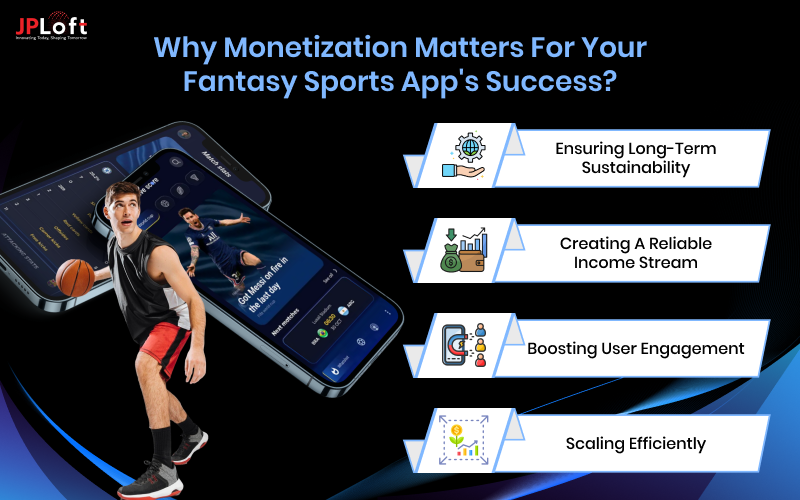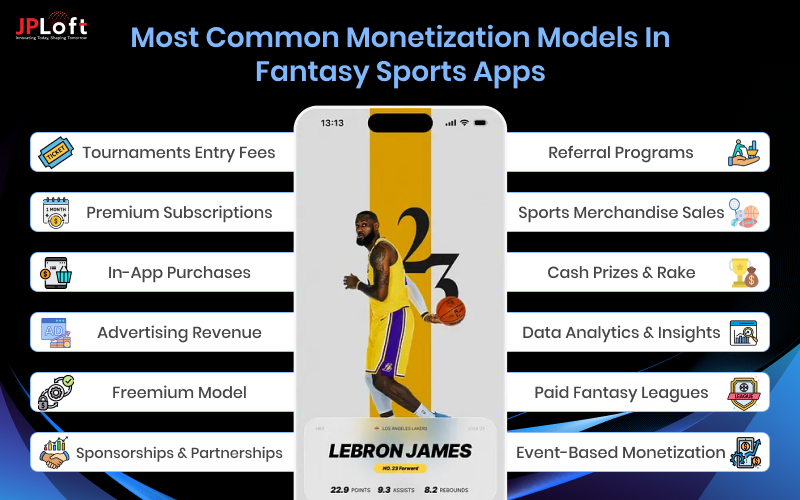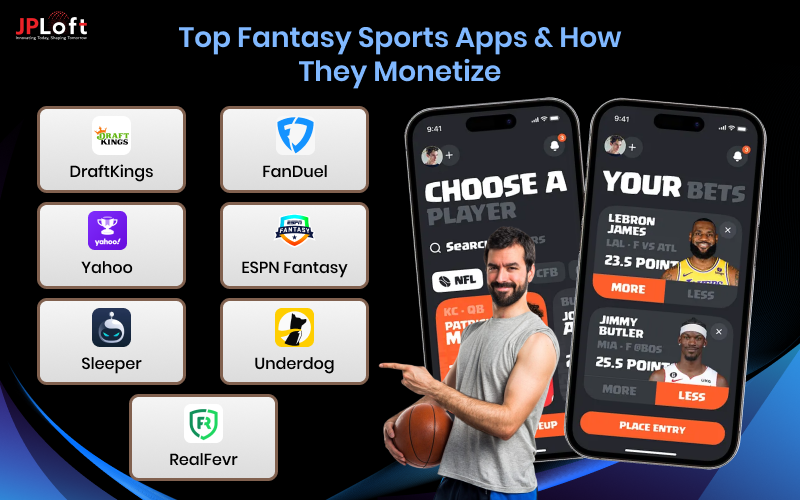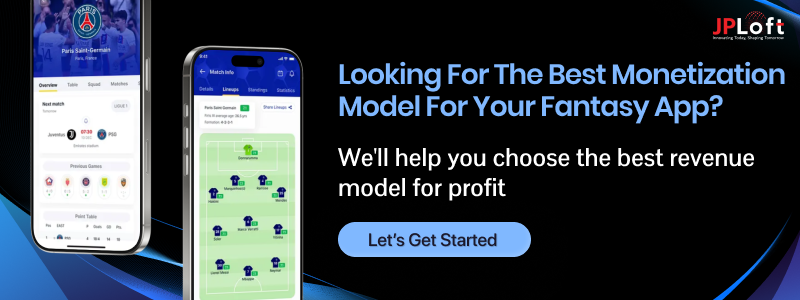As the fantasy sports industry continues to grow, fantasy sports apps have become the ideal platform for sports fans to connect, fight, and win.
But how do fantasy sports apps make money?
The answer lies in picking the right fantasy sports app business model and applying effective monetization strategies that increase revenue.
Understanding how to build sustainable revenue streams is important when creating a fantasy sports app.
From entry fees and in-app purchases to ads and subscriptions, there are several ways to drive revenue.
The best fantasy sports app monetization strategy for you relies on your target group and the features you offer.
This blog will explore the best revenue strategies for fantasy sports apps in 2025, helping you pick the most effective monetization model to ensure long-term success and growth in this competitive market.
Market Stats: The Fantasy Boom is Real
Before we dive into the best fantasy sports app revenue models, let's take a quick look at some key market stats that highlight just how lucrative this industry is becoming.

-
Global Market Growth: The global fantasy sports market was valued at USD 30.95 billion in 2023 and is poised to grow from USD 35.22 billion in 2024 to USD 99.09 billion by 2032, growing at a CAGR of 13.80% during the forecast period (2025–2032).
-
U.S. Market Size: In the United States, the fantasy sports services sector reached a market size of USD 10.3 billion as of May 2024.
-
User Demographics: Approximately 19% of Americans aged 18+ participate in fantasy sports, with a significant portion being college-educated males aged 18–34 earning over $50,000 annually.
-
European Market: The European fantasy sports market was valued at USD 1.05 billion in 2022 and is expected to grow at a CAGR of 12.56% from 2022 to 2028.
-
Platform Performance: The Fantasy Premier League alone boasts over 11 million registered users, making it the largest fantasy football game in the world.
-
Market Outlook: The global fantasy sports market is expected to grow by USD 10.13 billion from 2025 to 2029, driven by the launch of new apps and increased brand promotion through fantasy sports.
With these impressive market stats in mind, it's clear that the fantasy sports app market is full of opportunities.
Now, let’s explore the monetization strategies that can help you capitalize on this booming sector.
Why Monetization Matters for Your Fantasy Sports App's Success?
Developing a mobile app isn’t cheap, especially when it comes to a fantasy sports app. That’s why knowing how fantasy sports apps make money is important.
Why? Because it’s not just about developing a fantasy sports app. It’s about ensuring it produces steady revenue to support and grow your business.
A good fantasy sports app business model does more than just keep your app going. It offers long-term benefits, such as:

A] Ensuring Long-Term Sustainability
Even the most feature-packed fantasy sports app can fail without a good monetization strategy.
Did you know that 83% of apps fail due to a lack of a good revenue plan?
Having a reliable fantasy sports app revenue model ensures your app stays competitive and lasts the long haul.
B] Creating a Reliable Income Stream
Most mobile app developers create a fantasy sports app for involvement and profit.
A well-thought-out revenue model can help generate high returns while keeping users excited about joining and fighting.
Whether it's through entry fees, subscriptions, or in-app purchases, the options are endless.
C] Boosting User Engagement
Monetization isn't just about making money—it’s about enhancing the user experience.
Offering top fantasy sport app features like VIP leagues, in-game rewards, or exclusive content keeps users engaged and opens up new revenue opportunities.
D] Scaling Efficiently
With the right monetization strategy, building your fantasy sports app becomes a smooth process.
Top fantasy sports platforms like DraftKings and FanDuel improved their earnings through entry fees, advertisements, and paid subscriptions, creating millions yearly.
The trick to growing your earnings from a fantasy sports app is to change, improve, and grow at the right time.
Ready to unlock your app’s full earning potential?
Let’s dive into the best fantasy sports app business plans and discover how to make your app a revenue-generating powerhouse.
Most Common Monetization Models in Fantasy Sports Apps
How exactly do fantasy sports apps make money? We’ve covered it in different ways, but it’s time to study the business models in detail.
Yes, we’re going into the world of mobile app monetization strategies for fantasy sports apps.

Let’s break it down:
1. Entry Fees for Tournaments
The easiest way to earn. Fantasy sports apps charge users an entry fee to join tournaments or leagues. The more players, the bigger the prize pool.
This model brings in revenue each time a user joins, and let’s be honest, who doesn’t love the excitement of competition?
It’s a win-win for both players and app owners.
Benefits:
-
Generates consistent revenue per tournament.
-
Engages users who are looking for a high-stakes experience.
-
Can scale quickly with popular sports seasons.
Revenue Potential:
Huge potential, especially when you host popular leagues with high entry fees.
The more participants, the bigger the prize pool, leading to consistent revenue every time users compete.
2. Premium Subscriptions
Ever wondered how apps keep you hooked? Premium subscriptions are key!
Users pay a recurring fee to unlock exclusive features like advanced player stats, expert analysis, and VIP leagues.
It’s a great way to keep players engaged while ensuring steady revenue. Plus, exclusive content keeps users coming back for more!
Benefits:
-
Predictable recurring revenue.
-
Keeps serious players engaged with premium content.
-
Offers various subscription tiers for flexibility.
Revenue Potential:
With engaged users, the subscription model guarantees a steady revenue stream and keeps your app buzzing year-round.
Exclusive content and perks keep players hooked, ensuring they stay loyal. It is a win-win; users love the value, and you enjoy consistent earnings.
3. In-App Purchases
In-app purchases are like the cherry on top. Think boosts, coins, or special items that make the fantasy sports experience even more thrilling.
These small but exciting purchases can bring in extra revenue while keeping users engaged and entertained. With multiple options, users are more likely to explore and spend.
Just make sure your app security is top-notch, so every transaction is safe and smooth for your players.
Benefits:
-
Quick, simple purchases that keep users engaged.
-
Users can personalize their experience.
-
Doesn’t affect the core gameplay, so engagement remains high.
Revenue Potential:
Massive potential, especially when users are engaged and ready to spend a little extra for rewards.
Small in-app purchases can go a long way in boosting revenue and keeping users coming back for more!
4. Advertising Revenue
Let’s face it, ads are everywhere. For fantasy sports apps, advertising revenue is one of the most popular monetization methods.
Whether it's spot ads, video ads, or native ads, this model is a win-win: the app gets paid, and users get a free experience (with some breaks, of course).
Benefits:
-
The free-to-play model encourages a large user base.
-
Different ad formats keep revenue flowing.
-
Engages users even when they’re not actively playing.
Revenue Potential:
If your app has a big user group, ad revenue can be important.
Just ensure the ads don’t break the user experience too much, keeping the balance between making revenue and having a smooth experience.
5. Freemium Model
The paid model is a go-to for fantasy sports apps!
Users enjoy basic features for free, but if they want the good stuff like expert predictions, extra leagues, or advanced stats, they’ll need to switch to the premium version.
It’s the perfect way to attract users while giving them the chance to level up their game!
Benefits:
-
Draws in new users by offering free content.
-
Upsells premium features for a more personalized experience.
-
Converts users into paying customers over time.
Revenue Potential:
The freemium model can be highly successful if you offer enough value to entice people to improve.
By offering exclusive material or advanced features, you can urge them to pay for the premium experience.
6. Sponsorships and Partnerships
Let’s dive into sponsorships! Fantasy sports apps can team up with big brands, sports leagues, or media outlets to offer sponsored content or exclusive tournaments.
This not only boosts your app’s credibility but also brings in some serious revenue.
It’s a great way to attract attention, build partnerships, and create a win-win situation for both your app and the sponsors.
Ready to level up with sponsorships? Let’s make it happen!
Benefits:
-
Leverages existing brand recognition for increased revenue.
-
Adds credibility to your app.
-
Opens doors to exclusive promotions and partnerships.
Revenue Potential:
Big brands in the sports world are always eager to tap into passionate fan bases.
This monetization method holds huge potential, especially when you partner with major sponsors.
It’s a win-win, boosting both revenue and brand exposure.
7. Referral Programs
Let’s talk about referral programs. Get your users to do the marketing magic by offering rewards or bonuses when they bring in new players.
This word-of-mouth strategy is a fan favorite in fantasy sports app development.
It not only fuels user growth but also keeps your current players coming back for more. More players, more competition, and more excitement.
Ready to turn your loyal users into your app’s biggest promoters? Let’s make it happen.
Benefits:
-
Encourages organic growth.
-
Engages users to help market the app.
-
Rewards both the referrer and the referee.
Revenue Potential:
Referral programs can drive exponential growth, especially if your app offers compelling features players are eager to share.
By rewarding users for bringing in others, you can quickly expand your user base and boost engagement.
When planning your strategy, it’s also smart to factor in the fantasy sports app development cost, ensuring your marketing methods align with your overall budget and goals.
8. Fantasy Sports Merchandise Sales
Selling fantasy sports goods is a great way to boost your revenue! From branding clothes to gifts, fans of your app will love showing off their loyalty.
It’s not just about the extra cash; goods help create a better relationship with your neighborhood.
Whether it’s a shirt, cap, or limited-edition item, fans will happily represent your brand.
So, why take advantage of this chance and turn those passionate players into live advertisements for your app?
Benefits:
-
Fans love showing off their team spirit.
-
Adds a personalized element to the app experience.
-
Great for building a community of engaged users.
Revenue Potential:
Selling merchandise can be a successful extra stream, especially during busy sports seasons.
Fans love to show their support, and giving branded merchandise can bring in extra revenue while improving your app’s brand impact.
9. Cash Prizes & Rake
Cash prizes are a big draw for users, and fantasy sports apps can take a share of the entry fees, also known as the rake, as profit.
This model can produce significant revenue, especially when tournaments are high-stakes.
The bigger the prize pool, the more players flock in, making it a lucrative way to boost your app’s earnings while keeping users involved and excited.
Ready to cash in on this high-reward model? Let’s make it happen!
Benefits:
-
High engagement with prize-driven competitions.
-
Generates money with each user entry.
-
Keeps the user base excited and competitive.
Revenue Potential:
Large tournaments can bring in hefty rake fees, making this a solid revenue model when handled well.
With high-stakes events, you can make substantial profits while keeping people involved and excited to participate.
10. Data Analytics and Insights
Data analytics can be a major game-changer!
By giving premium stats, player insights, and performance data, you can draw serious players who are ready to pay for the inside information that boosts their chances of winning.
Imagine giving them the tools they need to level up their game, resulting in more involved users and steady revenue.
So, if you want your app to be a go-to source for winning strategies, data analytics is the way to go!
Benefits:
-
Valuable content that enhances the user’s experience.
-
Attracts players who want to gain an edge over their competition.
-
Adds long-term value to the app.
Revenue Potential:
Data-driven services have huge potential, especially for dedicated fantasy sports players eager to optimize their strategies.
Offering insights, stats, and analysis can not only enhance the user experience but also provide a valuable revenue stream.
11. Paid Fantasy Leagues
Want to create exclusive, high-roller leagues? Paid fantasy leagues allow users to join for a fee, with winners taking home bigger prizes.
This model offers a premium experience for top-tier players, drawing intense fans who are ready to spend for bigger rewards.
It’s a great way to raise the stakes and bring in revenue while giving an exciting experience for the serious players.
Ready to bring the top challenge to your app?
Benefits:
-
Premium leagues offer higher engagement and excitement.
-
Allows for higher entry fees and larger prize pools.
-
Builds a loyal, competitive community.
Revenue Potential:
Paid leagues offer great potential, especially during high-demand seasons.
Players are more likely to pay for a premium, exclusive experience that promises bigger prizes and elevated competition. It's a win-win for everyone involved!
12. Seasonal or Event-Based Monetization
Seasonal or event-based monetization is all about cashing in during big sports events like the Super Bowl, World Cup, or NBA playoffs.
These high-traffic moments open the door to charging higher entry fees and holding exclusive events that bring tons of players.
It’s a smart way to leverage the excitement around big tournaments, giving limited-time chances that make your app stand out and boost your revenue during these action-packed seasons.
Ready to maximize those big moments?
Benefits:
-
Leverages the excitement around major sports events.
-
Can charge higher fees during peak seasons.
-
Creates limited-time engagement opportunities.
Revenue Potential:
Big events equal big money! During major tournaments, people are ready to spend more to dive into the action, making this model highly lucrative.
It’s the perfect opportunity to cash in on the excitement and drive profits.
Top Fantasy Sports Apps & How They Monetize
Fantasy sports apps have turned everyday fans into strategic gamers, giving them the thrill of building dream teams and winning real rewards.
But let’s not kid ourselves, these apps are scoring big not just in users, but in revenue too.
Let's take a look at the monetization strategies used by the world's top fantasy sports apps:

► DraftKings: The King of DFS and Sports Betting
DraftKings mixes fantasy sports and sportsbook games, giving everything from daily fantasy contests to real-money sports bets.
If you’re planning to develop a fantasy sports app like DraftKings, adding both DFS and betting choices can significantly drive monetization.
Monetization Model: Entry Fees, Subscriptions, Betting Revenue, In-App Purchases.
► FanDuel: Multi-Sport Fantasy Action
FanDuel is known for its sleek app experience, massive tournaments, and coverage across the NFL, NBA, MLB, and more.
To monetize like FanDuel, offer frequent games with varying entry fees and work with major leagues to boost visibility.
Monetization Model: Entry Fees, Advertising, Premium Leagues, Sportsbook Integration.
► Yahoo Fantasy Sports: The Veteran’s Playground
Yahoo Fantasy has a loyal user base thanks to its long-standing trust, especially in seasonal fantasy leagues and expert analysis.
Developing a fantasy sports app like Yahoo? Focus on community, rich features, and ad placements to monetize efficiently.
Monetization Model: Advertising, Premium Features, Data Licensing.
► ESPN Fantasy: Where Sports Fans Go Big
Backed by the ESPN name, this app lives on trustworthiness and offers advanced player stats, exclusive material, and unique leagues.
Want to build something like ESPN Fantasy? Leverage exclusive media relationships and customizable features to draw users.
Monetization Model: Sponsored Content, In-App Ads, Premium Tools.
► Sleeper: The Social Fantasy App
Sleeper’s charm is in its community vibe. It mixes chat, leagues, and memes, turning fantasy into a social experience.
To develop a fantasy sports app like Sleeper, make sure your app includes strong in-app communication and free-to-play monetization strategies.
Monetization Model: In-App Purchases, Partnerships, Premium Features.
► Underdog Fantasy: The Best Ball Innovator
Underdog focuses on best ball drafts — a set-it-and-forget-it format that’s ideal for casual players. Its simplified contests and clean UI keep users engaged.
If you’re creating something like Underdog, simplicity and usability should lead your strategy.
Monetization Model: Entry Fees, Paid Contests, Referral Bonuses.
► RealFevr: Fantasy Meets NFTs
RealFevr adds a Web3 twist to fantasy sports, integrating blockchain-based NFTs and digital collectibles with traditional fantasy gaming.
Looking to stand out? Follow RealFevr’s path and merge fantasy with crypto for new revenue possibilities.
Monetization Model: NFT Sales, Entry Fees, Sponsorships.
How Do You Select the Right Monetization Model for Your Fantasy App?
Understanding how fantasy sports apps make money is the first step to turning your mobile app idea into a money-making machine.
The perfect fantasy sports app business model depends on a few key factors that deserve your attention.

-
Target Audience: Are your users casual players just here for the fun, or fantasy fanatics ready to dive deep? Casual players prefer a freemium model or ad-supported access, while competitive users often go for paid leagues or subscriptions. Analyze your users’ habits and give them what they crave.
-
Unique Value Proposition: What makes your app stand out on the scoreboard? Maybe it’s expert insights, live draft rooms, or slick UI. Whatever it is, use that edge to support premium pricing models like VIP access, in-app upgrades, or exclusive stats.
-
Market Trends: Keep your finger on the pulse of what works. Look at global giants like DraftKings or ESPN Fantasy, which succeed using a blend of entry fees, ads, premium subscriptions, and exclusive content. Learn from the best and bring your twist.
-
Scalability: Can your app grow with your audience? Your fantasy sports app monetization strategy should support expansion across seasons, user bases, and features. A flexible model sets you up for long-term wins.
-
User Engagement: Engagement is the real MVP. Keep users active with leaderboards, personalized challenges, and daily contests. More time spent in-app means more chances to monetize.
The winning play? Mix and match.
Combining ads, subscriptions, entry fees, and in-app purchases is how you build a profitable fantasy sports app that scores with users and your bank account.
How JPLoft Can Help You Build a Profitable Fantasy Sports App?
Fantasy sports apps are dominating the digital game, drawing in millions of users ready to strategize, compete, and win big.
If you’re thinking about launching your platform, now is the time to transform that vision into a revenue-generating reality.
Partner with JPLoft, the best fantasy sports app development company, to build a powerful, scalable, and profit-focused app that stands out in the crowd.
Need real-time score tracking, smooth API integration, or a smart mobile app monetization strategy? We cover it all with precision and expertise.
From app security to delivering the top features in a fantasy sports app, our team ensures your platform is fast, engaging, and built for long-term success.
All you need to do is bring your idea. We will turn it into a high-performance fantasy app that drives user engagement and steady revenue.
Let’s create something powerful together. Contact us today.
Conclusion
Building a successful fantasy sports monetization app requires choosing the right monetization model.
From paid subscriptions and entry fees to in-app purchases and data-driven services, your approach should be based on how users act and what your long-term goals are.
You can turn casual players into devoted users by offering them useful features and increasing engagement.
For maximum revenue, the best-performing apps frequently mix several monetization strategies.
With the right features, planning, and work, your fantasy sports app can be more than just a game.
The business can do well and keep people coming back season after season.
FAQs
Fantasy sports apps make money through various models like entry fees, subscriptions, in-app purchases, advertising, sponsorships, and premium features. These revenue streams capitalize on user engagement and competition, driving profitability.
Fantasy sports apps thrive by combining entry fees, premium subscriptions, in-app purchases, data-driven services, and partnerships with sports brands to create diverse, lucrative revenue streams.
Even free fantasy sports apps can generate substantial revenue. They leverage ad-supported models and in-app purchases to attract a wide user base. Monetization comes through ads, partnerships, premium upgrades, or paid leagues for competitive players.
The most profitable fantasy sports app model combines entry fees, paid leagues, and premium subscriptions for steady revenue and user retention.
Yes, ads can generate significant revenue for fantasy sports apps with large user bases. Placed strategically, ads enhance revenue without disrupting user experience or engagement.
Collaborating with sports brands or influencers unlocks lucrative sponsorships and boosts revenue. Special events, tournaments, and challenges with major leagues can attract more users, increasing income through entry fees, sponsorships, and exclusive content.















Share this blog